
The Rise of Solar Energy for Residential Rooftop Segment in Emerging Markets: Opportunities in MEA & LATAM
As the world transitions towards cleaner energy sources, residential rooftop solar systems are emerging as a transformative solution particularly in the Middle East & Africa (MEA) and Latin America (LATAM). These regions, blessed with abundant sunlight and rapidly growing energy demands, are witnessing a significant uptick in solar adoption. Governments, private sectors, and local communities are recognizing the potential of decentralized, renewable power to bridge energy access gaps and stabilize rising electricity costs.
Why Rooftop Solar is Gaining Ground
The residential rooftop segment has seen accelerated growth due to a convergence of factors
- Decreasing Solar Technology Costs: Over the last decade, the cost of solar panels, inverters, and storage systems has dropped dramatically, making solar solutions more accessible for middle-income households.
- Unreliable Grid Infrastructure: In many parts of Africa and Latin America, grid power is either unavailable or unreliable. Rooftop solar provides energy independence and resilience for homes and communities.
- Environmental Awareness: Growing awareness around climate change and the push for net-zero emissions have positioned solar energy as a preferred choice among eco-conscious consumers.
Key Market Opportunities in MEA
In the Middle East and Africa, rooftop solar power is becoming a vital solution to power challenges:
- South Africa is leading the charge with favourable net-metering policies and an urgent need to address rolling blackouts.
- Kenya, Nigeria, and Ghana are seeing increased investments in solar home systems and pay-as-you-go models.
- UAE and Saudi Arabia are expanding distributed solar policies to achieve ambitious clean energy goals under Vision 2030 frameworks.
Momentum in LATAM
- Latin America is equally poised by a solar boom
- Mexico and Chile offer strong solar irradiation and a maturing regulatory framework.
Smaller markets like Colombia, Peru, and Panama are emerging as next frontiers, driven by rural electrification programs and rooftop installations in urban zones.
The Role of Advanced Storage and Inverters
To fully harness solar potential, rooftop systems in these regions are increasingly being paired with energy storage solutions and hybrid inverters. These technologies allow consumers to use solar power during the night and ensure uninterrupted supply during outages—critical in areas with inconsistent grids.
Eastman: Powering Rooftop Solar Revolution
Eastman is proud to be at the forefront of the rooftop solar transformation across MEA and LATAM. With a comprehensive range of solar panels, lithium and tubular batteries, off-grid and hybrid inverters, Eastman offers reliable, cost-effective, and scalable solutions tailored for residential needs. Our commitment to quality and innovation ensures sustainable energy for every home empowering communities with clean, affordable power.
Conclusion:
The residential rooftop solar segment in emerging markets is more than a trend, it's a movement. As MEA and LATAM embrace decentralized energy, the future looks bright for homeowners seeking autonomy, sustainability, and savings. With the right mix of policy, technology, and consumer awareness, rooftop solar will illuminate millions of lives across the globe.
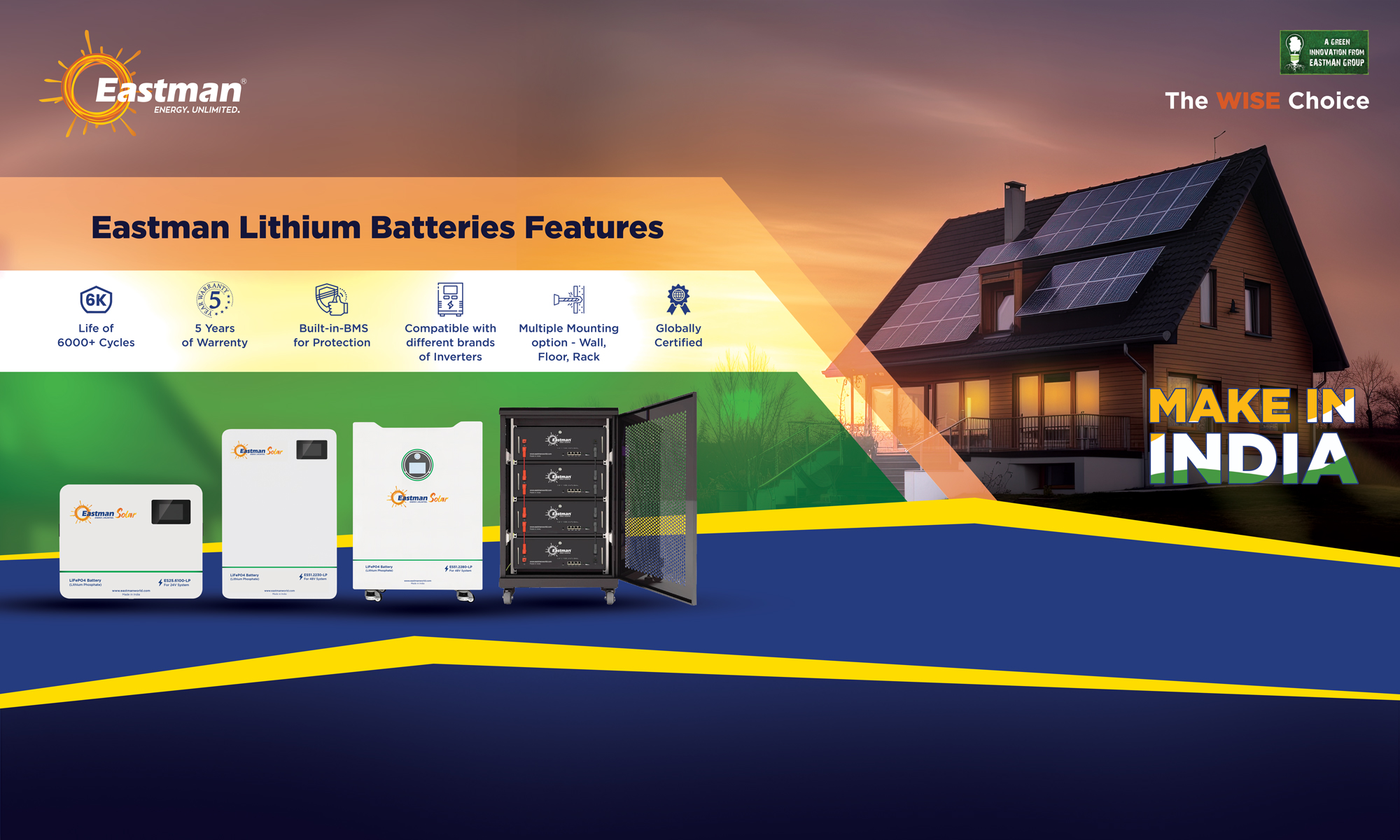
Get to Know More About Eastman Lithium Batteries - Made in India
The world is undergoing a revolutionary shift toward cleaner, greener energy solutions. As a result, the demand for advanced energy storage systems has skyrocketed, especially in renewable energy setups. Among the many players in the market, Eastman Lithium Batteries stand out as a game-changer in the energy storage space. Proudly made in India, these batteries are designed to offer superior performance, durability, and value to consumers looking for reliable energy solutions.
Let’s dive into the impressive features that make Eastman Lithium Batteries the preferred choice for consumers and businesses alike:
1. 6000+ Cycles: Long-Lasting Performance
One of the standout features of Eastman Lithium Batteries is their exceptional cycle life. With over 6000 charge and discharge cycles, these batteries provide a long-lasting energy storage solution. Compared to traditional lead-acid batteries that typically last for 300-500 cycles, Eastman Lithium Batteries offer significantly more durability and reliability. This means that users can enjoy years of worry-free performance before they need to think about replacing their battery. Whether it's for residential or commercial use, this long cycle life ensures a solid return on investment.
2. 5 Years of Warranty: Peace of Mind for Users
Eastman Lithium Batteries come with an industry-leading 5-year warranty, which reflects the manufacturer’s confidence in their product. This extended warranty assures customers that the battery is built to last and offers the highest level of protection against defects in materials or workmanship. The warranty provides peace of mind, ensuring that if any issues arise within the first five years, customers are fully covered. With such a commitment to quality, Eastman takes customer satisfaction to the next level.
3. In-Built Battery Management System (BMS)
The Battery Management System (BMS) is an essential component of any lithium battery, as it helps in monitoring and protecting the battery’s performance. Eastman Lithium Batteries come equipped with an in-built BMS, ensuring the battery operates efficiently and safely. The BMS plays a crucial role in:
Cell balancing: Ensuring that the battery cells work optimally.
Overcharging/Discharging protection: Preventing battery damage by controlling the charge cycles.
Thermal management: Keeping the battery within safe temperature limits.
State of Charge (SOC) monitoring: Keeping track of the remaining battery capacity. This built-in technology enhances the longevity of the battery and ensures reliable performance throughout its life.
4. Compatible with Different Brands of Inverters
One of the biggest advantages of Eastman Lithium Batteries is their versatility. These batteries are designed to be compatible with a wide range of inverters from various brands. This compatibility makes it easier for users to integrate Eastman batteries into existing solar setups or other energy systems without worrying about specific brand requirements. Whether you're looking to upgrade an old solar system or install a new one, Eastman Lithium Batteries provide a hassle-free solution that offers seamless integration.
5. Multiple Mounting Options
Every space has its unique requirements, and Eastman understands this need. That’s why they offer multiple mounting options for their lithium batteries, allowing users to place them in different configurations according to their available space. Whether you want to mount the battery horizontally, vertically, or even in a rack system, Eastman provides flexible solutions that make installation easy and convenient. This adaptability ensures that the battery can be installed in both residential and commercial settings with ease.
6. Globally Certified: Ensuring Quality and Safety
Eastman Lithium Batteries are not only a marvel of engineering but also hold global certifications, ensuring they meet international safety and quality standards. The certification process guarantees that these batteries adhere to strict guidelines for performance, safety, and environmental impact. This globally recognized certification makes them a trusted choice for both domestic and international consumers, reinforcing their position as a leading player in the battery industry.
Why Choose Eastman Lithium Batteries?
Superior Performance: With 6000+ cycles, Eastman Lithium Batteries last longer than traditional batteries, providing reliable performance.
Extended Warranty: A 5-year warranty gives users added confidence in the product’s durability.
Integrated Technology: The built-in Battery Management System ensures optimal performance, safety, and longevity.
Universal Compatibility: These batteries are designed to work with a wide range of inverters, making them perfect for upgrading or building new energy systems.
Flexibility in Installation: Multiple mounting options allow for easy and flexible installations in various settings.
Global Standards: The batteries are globally certified, meeting international safety and performance standards.
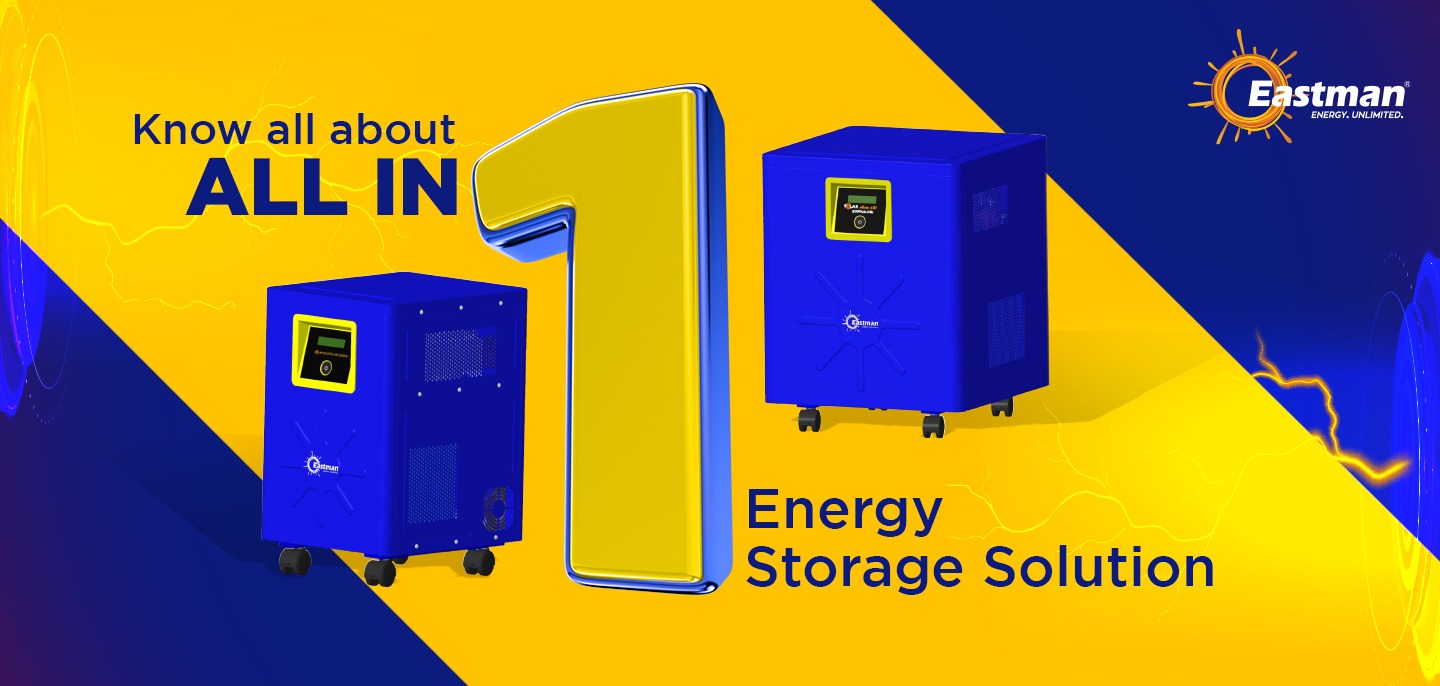
Know all about All in One - Energy Storage Solution
All-in-One Energy Storage Solutions: The Future of Efficient and Sustainable Energy Management
In an era where sustainability and energy efficiency are at the forefront of technological innovation, energy storage systems (ESS) have become indispensable. One of the most exciting developments in this field is the All-in-One Energy Storage Solution (ESS), a compact, integrated system designed to streamline energy management for both residential and commercial applications. These all-in-one systems combine essential components of energy storage—batteries, inverters, charge controllers, and more—into a single, user-friendly package.
Let’s explore why All-in-One ESS are gaining popularity and how they are changing the landscape of energy storage.
What is an All-in-One ESS?
An All-in-One Energy Storage Solution (ESS) is a self-contained unit that integrates multiple key components needed for efficient energy storage and management. These systems are typically designed to:
Store excess energy generated by renewable sources like solar or wind.
Convert stored energy into usable electricity.
Monitor and manage energy flows between storage, renewable generation, and the home or business.
The key advantage of these systems is their compact design, which consolidates all the necessary equipment—such as batteries, inverters, charge controllers, energy management systems (EMS), and sometimes backup power capabilities—into one unit. This all-in-one approach simplifies the installation process, reduces space requirements, and eliminates the need for multiple, separate components.
Key Components of an All-in-One ESS
An All-in-One ESS is typically made up of several integrated components that work together to manage the flow of electricity. Some of the primary components include:
Battery Storage: The heart of any ESS, typically made from lithium-ion or other advanced battery chemistries, which stores excess energy for later use.
Inverter: Converts the DC (direct current) electricity generated by renewable energy sources like solar panels or stored in the battery into AC (alternating current), which is what most household and business appliances use.
Charge Controller: Regulates the charging and discharging of the battery, ensuring that it is charged efficiently and not overcharged, which can prolong battery life.
Energy Management System (EMS): A sophisticated software platform that monitors and manages the entire system, optimizing energy use and storage, tracking performance, and allowing for remote monitoring and control.
Backup Power: Many All-in-One ESS units come with backup power capabilities, offering peace of mind in the event of power outages.
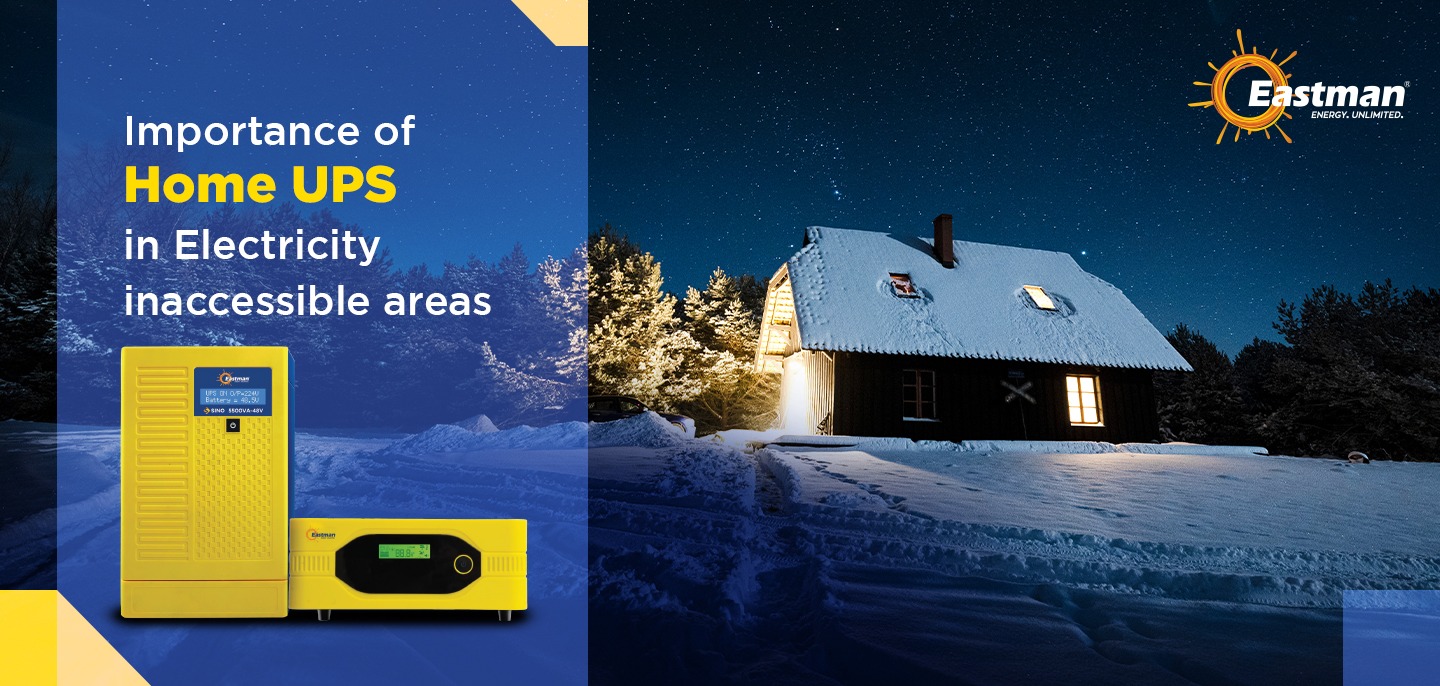
The Importance of Home UPS in Electricity-Inaccessible Areas
In many parts of the world, particularly in rural or remote areas, access to reliable electricity remains a significant challenge. For millions of people, power outages are a frequent occurrence, and in some regions, there is no electricity infrastructure at all. In such situations, a Home UPS (Uninterruptible Power Supply) becomes an essential tool for households. These systems are designed to provide a backup power source during electricity disruptions, ensuring that daily activities can continue uninterrupted. In this blog, we will explore the importance of Home UPS systems in electricity-inaccessible areas, highlighting their benefits for safety, security, sustainability, and quality of life.
1. Providing Reliable Power During Outages
In electricity-inaccessible areas, power outages can be prolonged, sometimes lasting for hours or even days. A Home UPS provides a crucial backup power solution that helps maintain essential services during these outages. Unlike traditional generators, which require fuel and can be cumbersome to operate, a UPS system stores power in batteries, allowing it to deliver energy instantly when the grid fails. This feature makes it ideal for areas with frequent power interruptions or where a stable power supply is not guaranteed.
Home UPS systems can keep lights, fans, refrigerators, and communication devices running, ensuring that households can continue their daily routines even when the electricity grid is down. Whether it's keeping food fresh in the refrigerator or enabling communication via phones and radios, a Home UPS ensures that basic needs are met during periods without power.
2. Enhancing Safety and Security
In areas with unreliable electricity, blackouts can lead to safety risks, particularly during the night when darkness creates hazards, and security systems are compromised. A Home UPS system plays a vital role in keeping lighting systems operational during power cuts, reducing the risks of accidents and improving overall safety. Whether it's guiding someone through the house or preventing falls and injuries, consistent lighting makes a big difference.
Furthermore, many homes in electricity-inaccessible areas rely on security systems like alarms, cameras, and motion sensors. A Home UPS ensures that these systems continue to function during outages, enhancing the security of the home and protecting against theft or break-ins. The ability to maintain functioning security systems is critical in off-grid areas where police or emergency services may not be immediately available.
3. Reducing Dependence on Fuel-Driven Generators
In areas where the power grid is either unavailable or unreliable, many households rely on fuel-driven generators to supply electricity. While these generators can be effective, they come with several drawbacks, including high fuel costs, maintenance requirements, and environmental pollution. Additionally, fuel-powered generators are often noisy, which can be disruptive, especially in residential areas.
A Home UPS offers a more cost-effective and sustainable alternative. These systems are typically powered by lithium-ion batteries, which can be charged using renewable energy sources like solar power. Once fully charged, a UPS system can provide backup power for hours without the need for additional fuel. This not only reduces the long-term cost of relying on fuel but also promotes a cleaner and quieter living environment.
For households with access to solar energy, the UPS system can be charged using solar panels, creating a self-sustaining energy loop. This setup significantly reduces reliance on traditional power sources and contributes to a more sustainable and independent energy solution.
4. Improving Quality of Life
Electricity is essential for modern living, and its absence can severely impact daily activities. For residents of electricity-inaccessible areas, a Home UPS system is an invaluable asset that improves quality of life in several ways.
Comfort and Convenience: A UPS system ensures that essential appliances like fans, air conditioning, and water pumps continue to operate during power cuts. In hot climates, for example, access to cooling systems can make the difference between comfort and extreme discomfort. The same goes for water pumps, which are critical for accessing clean water in many off-grid homes.
Communication and Connectivity: In rural or remote areas, staying connected is important, whether for emergency services, education, or social connections. A Home UPS ensures that communication devices such as mobile phones, radios, and internet routers stay operational during blackouts. This is especially crucial in emergency situations, where being able to call for help or access vital information can be a matter of life and death.
Education: In areas where online education is becoming increasingly important, power disruptions can interfere with learning. A UPS can keep devices like laptops and tablets powered, allowing students to continue their lessons without interruption, even in the event of a power outage.
5. Supporting Sustainable Living
In off-grid areas, sustainability is a major concern, as traditional power sources like fossil fuels contribute to environmental degradation. Home UPS systems offer a way to address these concerns by integrating with renewable energy sources, such as solar panels or wind turbines.
Solar-powered UPS systems are especially beneficial in areas with abundant sunlight. They provide a clean, renewable, and cost-effective way to store energy, reducing the need for fuel-driven generators. This approach not only supports a more environmentally friendly lifestyle but also contributes to long-term energy independence, as households can generate and store their own power.
6. Affordable and Accessible Energy Solution
For many households in off-grid areas, building and maintaining an extensive energy infrastructure can be prohibitively expensive. Home UPS systems offer a more affordable and accessible solution. They come in a variety of sizes and price points, making them suitable for different energy needs. Smaller systems are ideal for powering just a few essential devices, while larger systems can support more extensive energy requirements.
The ease of installation is another key advantage of Home UPS systems. Unlike traditional generators that may require professional installation and ongoing maintenance, a UPS system is typically plug-and-play. Users can set it up easily and start using it right away, making it a practical solution for off-grid households with limited technical expertise.
Conclusion
A Home UPS system is a game-changer for households in electricity-inaccessible areas. By providing reliable backup power, improving safety, reducing dependence on fuel-driven generators, and supporting sustainable living, these systems significantly enhance the quality of life for residents in off-grid locations. With the added benefit of integrating renewable energy sources, Home UPS systems also contribute to long-term energy independence and environmental sustainability.
As the demand for more affordable and reliable energy solutions continues to grow, the Home UPS is becoming an indispensable tool for communities in electricity-inaccessible areas. It ensures that people can continue to live safely, comfortably, and independently, even in regions where power from the grid is a distant dream.

5 Common Faults in Lithium Batteries
As renewable energy sources like solar power become more widespread, residential lithium-ion battery storage systems have become essential for homeowners looking to store energy for later use. These systems help reduce dependence on the grid, lower electricity bills, and provide backup power during outages. However, like all technology, lithium-ion batteries are susceptible to faults and performance issues. Understanding these common problems can help homeowners maintain their systems properly and maximize the lifespan and efficiency of their storage batteries.
In this blog, we'll explore the most common faults in residential lithium storage batteries and provide some tips on how to address them.
1. Overcharging and Over discharging
Overcharging occurs when a battery is charged beyond its maximum voltage capacity, and over discharging happens when the battery is drained below a safe voltage level. Both of these conditions can damage the battery’s internal components, reducing its lifespan and efficiency.
Causes:
Faulty Battery Management System (BMS): The BMS is responsible for monitoring battery health and preventing overcharging or overdischarging. If the BMS malfunctions, it can fail to protect the battery from these issues.
Poor Charging Practices: Using the wrong type of charger or charging the battery too often can cause overcharging, especially if the system is not managed properly.
Prevention:
Monitor Charging Cycles: Use a reliable Battery Management System (BMS) that can track charging and discharging cycles. Many residential systems come with apps or monitoring tools that allow you to keep track of battery health.
Automatic Cutoffs: Modern lithium storage systems are designed with automatic cutoff points that disconnect the battery once it reaches a full charge or near depletion, preventing damage.
2. Battery Swelling
Battery swelling is a common issue, especially with older or poorly-maintained lithium-ion batteries. This occurs when the battery cells overheat, often due to overcharging, overdischarging, or exposure to extreme temperatures.
Causes:
Excessive Heat: Overcharging, poor ventilation, and exposure to high temperatures can cause the battery to overheat, which leads to internal chemical reactions that create gas buildup, causing the battery to swell.
Age and Wear: Over time, repeated charging and discharging cycles can lead to the degradation of the battery’s internal components, making it more prone to swelling.
Prevention:
Proper Ventilation: Ensure that the battery storage area is well-ventilated to prevent heat buildup. Keep the battery away from direct sunlight or heat sources.
Temperature Management: Use temperature sensors and systems that monitor the battery's operating temperature. Some lithium-ion batteries are equipped with thermal management features to regulate internal temperature.
3. Capacity Loss
Over time, all lithium-ion batteries experience some level of capacity loss, meaning they can't store as much energy as they once could. However, rapid or significant capacity loss within a short period can indicate a problem with the battery.
Causes:
Repeated Overcharging or Overdischarging: Frequent overcharging or deep discharging can stress the battery and accelerate capacity degradation.
High Cycling Frequency: A high number of charge and discharge cycles, particularly at high rates, can also contribute to the loss of capacity.
Poor Battery Quality: Some cheaper, lower-quality lithium-ion batteries may degrade faster than higher-quality counterparts.
Prevention:
Regular Monitoring: Use a Battery Management System (BMS) or a monitoring app to track battery health and ensure you're not overcharging or overdischarging your system.
Use the Battery Efficiently: Try not to constantly deplete the battery to its lowest charge or charge it to full capacity. Keeping the battery between 20% and 80% charge can help prolong its lifespan.
4. Voltage Imbalance Between Cells
Lithium-ion batteries typically consist of multiple cells connected in series and parallel to achieve the desired voltage and capacity. If these cells are not properly balanced, some cells may become overcharged or undercharged, leading to reduced efficiency and potential damage.
Causes:
Defective BMS: A faulty BMS may fail to balance the voltage across individual cells, causing some cells to charge at different rates than others.
Ageing Cells: Over time, the internal resistance of individual cells may increase, causing voltage imbalances.
Prevention:
Balanced Charging: Use a BMS with active cell balancing features to ensure that all cells maintain a similar charge level.
Regular Inspections: Inspect the battery periodically for signs of imbalance, such as inconsistent voltage readings across cells. Many systems have built-in diagnostics for this.
5. Thermal Runaway
Thermal runaway is one of the most dangerous issues with lithium-ion batteries. It occurs when a battery experiences a rapid increase in temperature, often leading to a fire or explosion. Thermal runaway is typically caused by internal short circuits, overcharging, or physical damage to the battery.
Causes:
Overcharging: Charging a battery beyond its voltage limit can increase internal temperature, eventually triggering thermal runaway.
Internal Short Circuits: A short circuit can occur due to physical damage to the battery cells or degradation over time.
External Heat Sources: Exposure to high ambient temperatures or direct sunlight can cause a lithium battery to overheat, increasing the risk of thermal runaway.
Prevention:
Proper Battery Management: Ensure that your BMS has built-in protection against overcharging, over discharging, and temperature extremes.
Temperature Control: Install a thermal management system or cooling fans in the battery storage area to prevent excessive heat buildup.
Use Quality Batteries: Ensure that your battery comes from a reputable manufacturer with built-in safety mechanisms.
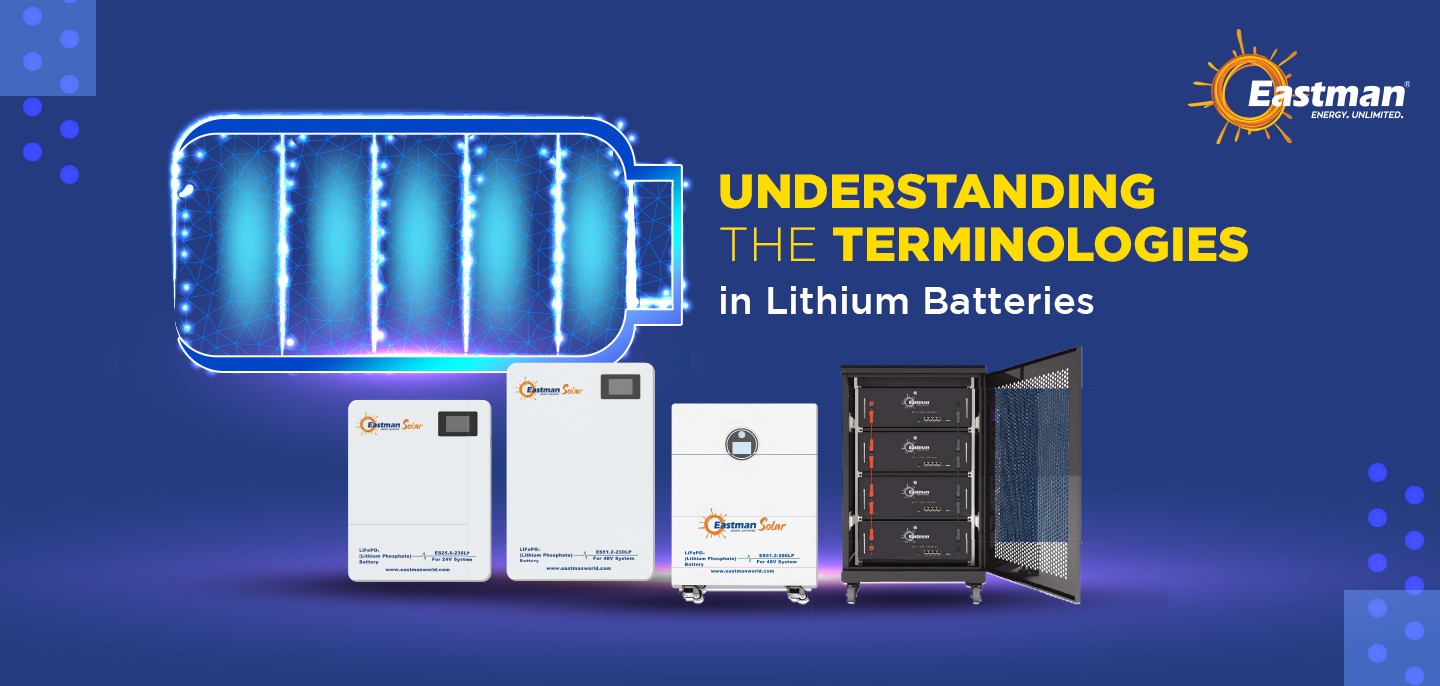
Understand the Terminologies in Lithium Batteries
Lithium batteries are an integral part of modern technology, powering everything from smartphones and laptops to electric vehicles and renewable energy storage systems. However, the terminology surrounding lithium-ion batteries can be confusing, especially for those who are new to the field. To help you navigate this complex subject, we’ve broken down the most commonly used terms in the world of lithium batteries. Whether you're a tech enthusiast or a developer in the energy sector, this blog will give you a clearer understanding of the key concepts in lithium battery technology.
1. Lithium-ion (Li-ion) Battery
The term lithium-ion or Li-ion refers to a type of rechargeable battery that uses lithium ions to store and release energy. These batteries are known for their high energy density, light weight, and long cycle life compared to other battery chemistries like lead-acid or nickel-cadmium. They are the most common type of rechargeable batteries used in consumer electronics and electric vehicles (EVs).
2. Anode and Cathode
Anode: The anode is the negative electrode in a lithium-ion battery. During discharge (when the battery is providing power), lithium ions move from the anode to the cathode. In the recharging process, lithium ions move in the reverse direction, from the cathode back to the anode.
Cathode: The cathode is the positive electrode in a lithium-ion battery. During discharge, it receives the lithium ions released by the anode, and when the battery is charging, lithium ions are transferred back to the anode.
3. Electrolyte
The electrolyte is a critical component in a lithium-ion battery. It is a chemical medium (usually a lithium salt dissolved in a solvent) that facilitates the movement of lithium ions between the anode and cathode during charging and discharging. The electrolyte is responsible for maintaining the flow of ions, which is essential for energy storage and release. Different electrolyte compositions can impact the battery’s efficiency, stability, and temperature tolerance.
4. Cycle Life
Cycle life refers to the number of complete charge and discharge cycles a battery can undergo before its capacity falls to a certain percentage of its original capacity (usually around 80%). A longer cycle life means the battery will last longer and require fewer replacements. Lithium-ion batteries typically have a cycle life of anywhere from 2000 to 7000 cycles, depending on the specific battery chemistry and usage conditions.
5. Energy Density
Energy density is a measure of how much energy a battery can store relative to its size or weight. It is usually expressed in watt-hours per kilogram (Wh/kg) or watt-hours per liter (Wh/L). Higher energy density means the battery can store more power in a smaller or lighter package, which is crucial for applications like electric vehicles and portable electronics.
Gravimetric energy density refers to energy storage per unit weight (Wh/kg).
Volumetric energy density refers to energy storage per unit volume (Wh/L).
6. Charge Rate (C-rate)
The C-rate defines the speed at which a battery can be charged or discharged relative to its capacity. For example, a battery with a capacity of 1,000 mAh (milliampere-hours) that can be charged at 1C would take one hour to fully charge (1C = full charge in one hour). If the same battery were charged at 2C, it would be fully charged in 30 minutes. Higher C-rates can lead to faster charging, but they may reduce the battery's lifespan or cause it to overheat if not managed properly.
7. State of Charge (SOC)
The State of Charge (SOC) is a measure of the remaining charge in a battery as a percentage of its total capacity. A fully charged battery has an SOC of 100%, and a completely discharged battery has an SOC of 0%. Monitoring SOC is essential for battery management systems (BMS) to prevent overcharging or deep discharging, both of which can damage the battery.
8. Depth of Discharge (DOD)
Depth of Discharge (DOD) refers to the percentage of a battery's capacity that has been used. For instance, if you have a battery with a 1000 mAh capacity and you use 500 mAh, the DOD would be 50%. Similar to SOC, DOD is crucial for understanding how much energy has been drawn from the battery and its remaining life. Typically, batteries have a recommended DOD limit to prolong their lifespan.
9. Battery Management System (BMS)
A Battery Management System (BMS) is an essential component that monitors and manages the battery’s performance. It ensures the battery operates within safe parameters, such as preventing overcharging, deep discharge, or excessive temperature. A BMS also balances the charge between individual cells to prevent imbalances that could reduce the battery’s overall lifespan or performance.
10. Overcharge and Over discharge Protection
Overcharge Protection: This refers to systems that prevent a battery from being charged beyond its maximum voltage, which can cause overheating, swelling, or even thermal runaway.
Over discharge Protection: This prevents the battery from being discharged below a safe voltage level, which can damage the internal structure of the battery and reduce its lifespan.
Both protections are crucial for ensuring the safety and longevity of lithium-ion batteries.
11. Thermal Runaway
Thermal runaway is a dangerous condition in which a battery's temperature rapidly increases, leading to a self-perpetuating chain reaction. This can be triggered by overcharging, physical damage, or exposure to high temperatures. It can cause the battery to catch fire or even explode. Modern lithium-ion batteries are designed with protective measures to reduce the risk of thermal runaway.
12. Self-Discharge Rate
Self-discharge refers to the gradual loss of charge that occurs even when a battery is not in use. Lithium-ion batteries have a relatively low self-discharge rate compared to other rechargeable batteries like nickel-cadmium, but they still lose charge over time. This is important to consider when storing lithium batteries for long periods.
13. Voltage (V)
Voltage is the potential difference between the positive and negative terminals of a battery. It is what drives the current through a circuit. The nominal voltage of a lithium-ion cell is typically around 3.6–3.7 volts, and the fully charged voltage is around 4.2 volts. Understanding the voltage is important when designing circuits to ensure compatibility and safety.
14. Watt-hour (Wh)
A watt-hour (Wh) is a unit of energy that describes how much energy a battery can store or deliver. It’s calculated by multiplying the battery’s voltage by its capacity (in ampere-hours). For example, a 3.7V battery with a capacity of 2,000mAh (2Ah) would have an energy capacity of 7.4 Wh (3.7V x 2Ah).
Conclusion
As lithium batteries continue to dominate the energy storage market, understanding the terminology surrounding them is essential for consumers, engineers, and manufacturers alike. By grasping the key concepts like anode, cathode, cycle life, energy density, and battery management, you can better appreciate how these powerful devices work and the role they play in powering our modern world.
The continued innovation and understanding of these terminologies will also help shape the future of battery technologies, driving progress in renewable energy, transportation, and consumer electronics.
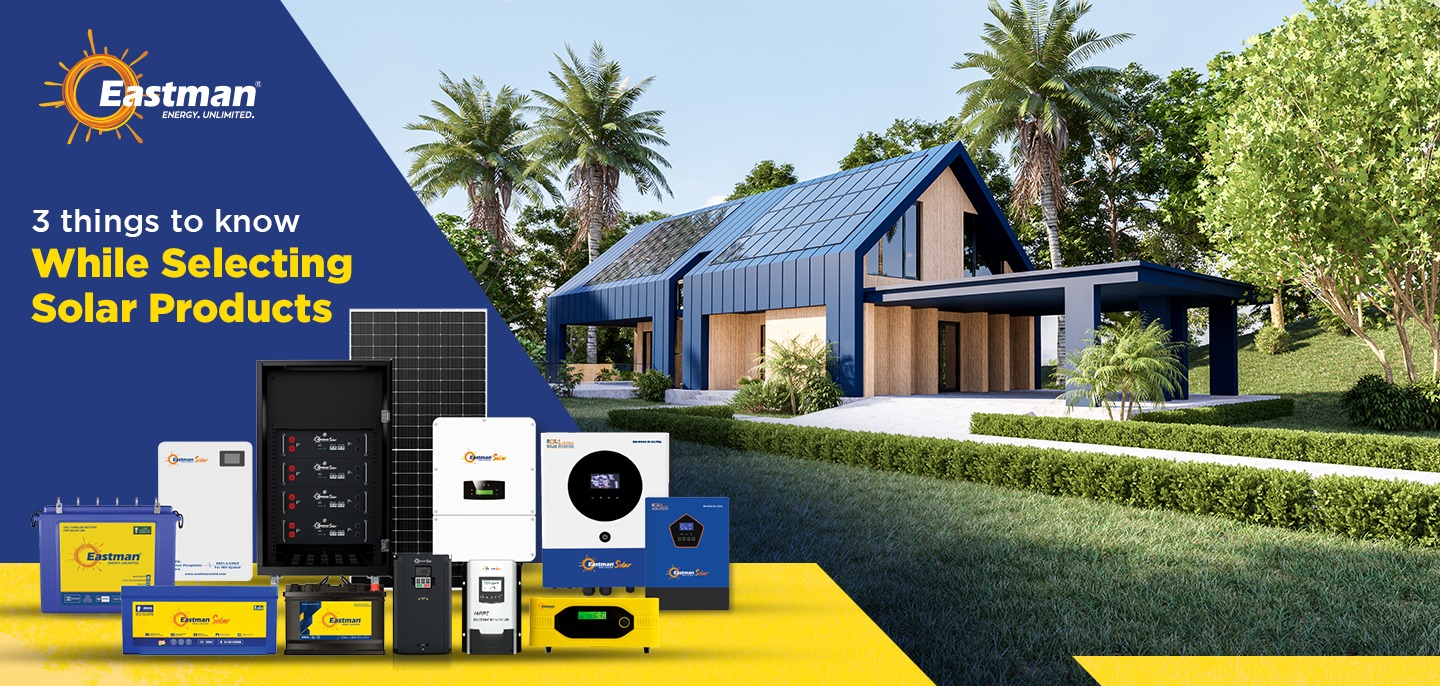
3 things to know While Selecting Solar Products
As solar energy becomes an increasingly popular choice for homeowners and businesses, selecting the right solar products can be overwhelming. With so many options available—solar panels, inverters, batteries, and charge controllers—it’s crucial to make informed decisions that maximize energy efficiency, minimize costs, and ensure long-term reliability. Whether you’re considering a small residential setup or a large-scale commercial system, here are three essential things to keep in mind while selecting solar products.
Efficiency and Performance
Why It Matters: Efficiency directly affects how much energy your solar system can generate, store, and use. The more efficient the solar products, the more electricity you can generate from the available sunlight, meaning more savings on energy bills and a quicker return on investment.
What to Consider:
Solar Panels: The efficiency of solar panels determines how much sunlight they can convert into electricity. Monocrystalline panels typically have the highest efficiency (18-22%), making them ideal for areas with limited roof space. Polycrystalline panels are slightly less efficient but more affordable, while thin-film panels offer flexibility and are often used for specialized applications.
When selecting solar panels, look for those with higher efficiency ratings if space is limited or you want to maximize your energy output. High-efficiency panels may come at a premium cost, but their long-term performance justifies the investment by generating more power over time.
Inverters: The inverter is responsible for converting the DC (direct current) power generated by the panels into AC (alternating current) power that can be used in your home or business. Choose an inverter with Maximum Power Point Tracking (MPPT) technology, which helps extract the maximum amount of energy from each panel, particularly under varying sunlight conditions. The inverter's efficiency is important too—typically ranging from 95% to 98%—as a higher-efficiency inverter will minimize energy loss during conversion, ensuring the system performs optimally.
Batteries: If you're integrating energy storage into your system, the battery's efficiency is key. Lithium-ion batteries generally offer higher round-trip efficiency (90-95%) than traditional lead-acid batteries, meaning more of the energy you store is usable later.
Quality and Durability
Why It Matters: Solar products are long-term investments, with many systems expected to last 20-30 years. The quality and durability of the components you choose directly impact the system’s longevity, performance, and maintenance costs.
What to Consider:
Warranties: Quality products usually come with comprehensive warranties. For example, high-quality solar panels typically offer a 25-year performance warranty, guaranteeing that they will produce a certain level of energy over their lifetime. Inverters, on the other hand, typically have a warranty of 5-10 years. Always check the warranty coverage and consider manufacturers that stand behind their products with solid customer support.
Weather Resistance: Solar panels and other components are exposed to outdoor elements like wind, rain, snow, and extreme temperatures. Look for solar panels with a high IP rating (Ingress Protection), typically IP65 or higher, which ensures they are dust- and water-resistant. Additionally, check if your solar products are rated to withstand heavy winds and hail if you live in a region prone to such weather.
Material Quality: Choose products made from high-grade materials, as these tend to perform better and last longer. Monocrystalline silicon panels, for example, are made from a single continuous crystal structure, which gives them superior efficiency and durability compared to polycrystalline or thin-film panels. Similarly, premium inverters often use advanced cooling technology to prevent overheating and ensure long-term reliability.
Cost and Return on Investment (ROI)
Why It Matters: While solar energy offers tremendous long-term savings, it's important to balance initial costs with the expected return on investment (ROI). Choosing the right products can make a significant difference in how quickly you recoup your investment and start saving on energy bills.
What to Consider:
Upfront Costs: Solar products, such as panels, inverters, and batteries, can be a significant upfront investment. While more efficient and durable products typically come at a higher cost, they often deliver better long-term savings. For instance, high-efficiency monocrystalline panels may cost more initially, but they generate more power over their lifespan compared to lower-efficiency alternatives, leading to greater overall savings.
Incentives and Rebates: Take advantage of government rebates, tax credits, and incentives available in your region. These can significantly reduce the upfront costs of installing a solar system. For example, in many regions, solar installations are eligible for investment tax credits (ITC) or grants, which can cover a substantial portion of the initial investment.
Payback Period and Savings: Calculate the payback period, which is the time it will take for your solar system to pay for itself through energy savings. A typical residential solar system has a payback period of around 6-8 years, after which you’ll be enjoying almost free electricity. Be sure to consider factors like local electricity rates, how much sunlight your location receives, and the system’s energy output when estimating savings. Some systems with integrated energy storage (batteries) may take longer to pay off but can offer more energy independence, especially in regions prone to power outages.
Conclusion
Choosing the right solar products is essential for maximizing the performance, efficiency, and financial benefits of your solar energy system. By keeping these three key factors in mind—efficiency, quality, and cost/ROI—you can make informed decisions that will ensure you get the best value for your investment.
Whether you're installing a solar system for your home or business, consider working with trusted and reputable brands that offer high-quality components with long-term warranties, excellent performance, and strong customer support. Solar energy is not just an environmentally-friendly solution but also a financially savvy investment, and with careful selection, you can make it work for you.
For reliable, high-performance solar solutions, Choose Eastman—a trusted name in solar energy products, offering high-quality inverters, batteries, and solar panels that deliver efficiency, durability, and long-term savings.
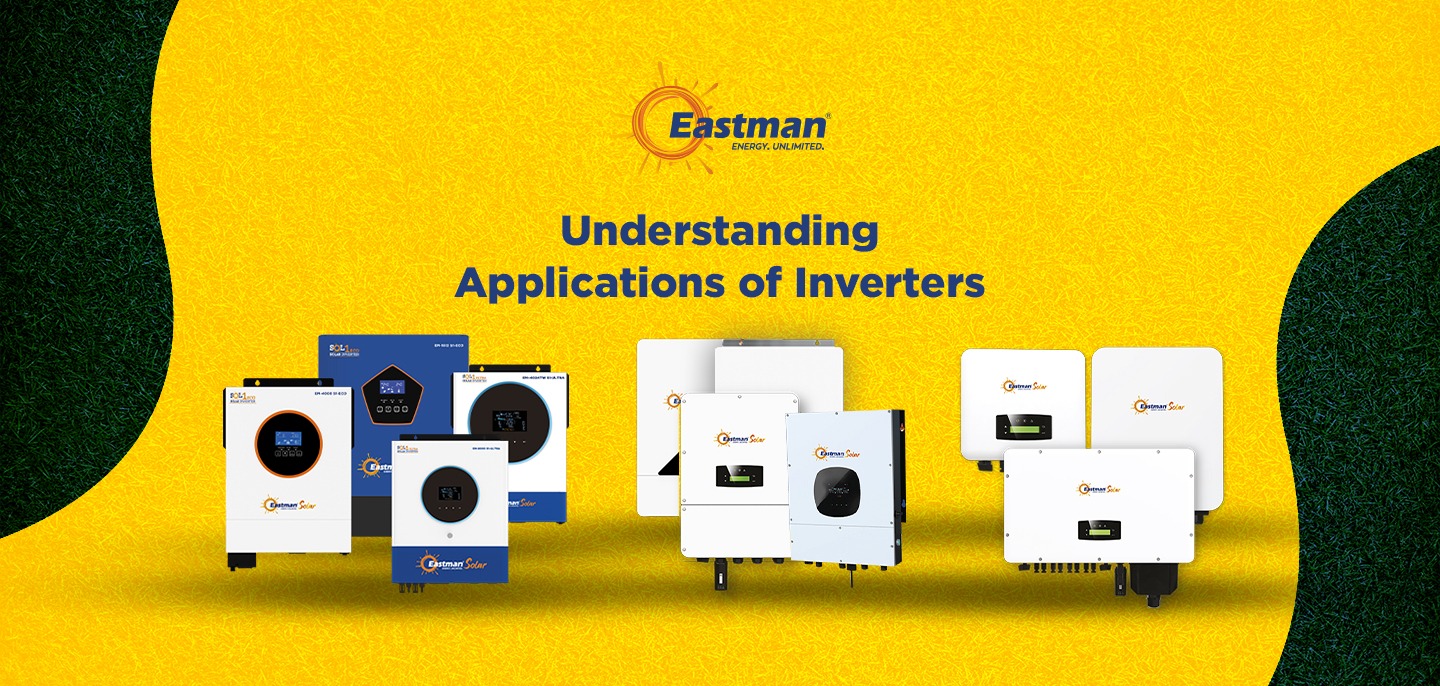
Understanding Applications of Inverters
Inverters play a pivotal role in modern energy systems, converting direct current (DC) power generated by renewable sources like solar panels into alternating current (AC) power that can be used in homes and businesses. The rise of renewable energy technologies has led to the development of various types of inverters, each designed for specific applications. In this blog, we will explore the three main types of inverters: Off-Grid Inverters, Grid-Tie Inverters, and Hybrid Inverters, and discuss why Eastman Inverters are a top choice for energy solutions.
1. Off-Grid Inverters: Empowering Remote Areas
What are Off-Grid Inverters?
Off-grid inverters are designed for use in systems that are not connected to the utility grid. These systems are most commonly used in remote areas where access to the grid is unavailable or unreliable. An off-grid inverter helps convert DC power from solar panels or other renewable sources into usable AC power to supply appliances and other electrical devices in homes or businesses.
Applications of Off-Grid Inverters
Remote and Rural Areas: Off-grid inverters are ideal for homes or businesses in areas far from utility infrastructure, such as rural villages, remote cottages, and agricultural installations. These locations benefit from clean, renewable energy without needing to connect to the electricity grid.
Emergency Power Backup: In case of grid failures or natural disasters, off-grid inverters provide a reliable backup power solution, ensuring that critical systems such as refrigeration, lighting, and medical equipment remain operational.
Sustainable Living: Off-grid inverters are commonly used in sustainable living initiatives. Individuals and families seeking to reduce their carbon footprint often opt for solar-powered off-grid systems, which can be paired with storage batteries to maximize energy independence.
2. Grid-Tie Inverters: Integrating Solar Power with the Grid
What are Grid-Tie Inverters?
Grid-tie inverters, also known as grid-connected inverters, are used in systems that are connected to the public utility grid. These inverters allow homeowners or businesses to feed excess solar or renewable energy back into the grid, reducing electricity bills or earning credits in the form of net metering. Essentially, they convert the DC power generated by solar panels into AC power that is synchronized with the electrical grid.
Applications of Grid-Tie Inverters
Residential Solar Systems: One of the most common applications for grid-tie inverters is in residential solar energy systems. These systems allow homeowners to reduce their dependence on the grid and take advantage of solar energy, reducing utility costs and promoting environmental sustainability.
Commercial Solar Systems: Businesses can also benefit from grid-tie inverters by installing large-scale solar energy systems. These systems can help lower operating costs and reduce their carbon footprint while allowing the company to contribute to the grid.
Utility-Scale Solar Projects: Large solar farms and renewable energy plants often use grid-tie inverters to feed solar power directly into the grid, which can supply clean energy to thousands of homes and businesses.
3. Hybrid Inverters: The Best of Both Worlds
What are Hybrid Inverters?
Hybrid inverters combine the functions of both off-grid and grid-tie inverters, allowing systems to be connected to the utility grid while also providing the ability to store excess energy in batteries. This feature is especially beneficial for consumers who want the flexibility of drawing power from either the grid or their own solar storage, depending on availability.
Applications of Hybrid Inverters
Energy Independence: Hybrid inverters are ideal for homeowners or businesses that want to reduce reliance on the grid and rely more on their own renewable energy systems. By storing excess energy in batteries during peak sunlight hours, users can consume it during the night or during power outages.
Battery Storage Systems: Hybrid inverters are commonly used in conjunction with energy storage systems like lithium-ion batteries. This combination allows consumers to optimize the use of solar energy, store excess power, and use it during times when solar energy production is low.
Load Shifting and Peak Shaving: Hybrid systems enable users to "shift" their electricity use to off-peak hours, thus saving on energy costs. They can also "shave" demand during peak periods, which helps to manage energy use and reduce the cost of electricity consumption.
Why Eastman Inverters Are the Best Choice for Your Energy Needs
Eastman Inverters have established themselves as leaders in the renewable energy space for several key reasons:
High Efficiency: Eastman inverters are engineered to maximize energy conversion efficiency, which translates to better performance and lower energy costs for users.
Reliability: Built with rugged, durable materials, Eastman inverters are designed to withstand extreme weather conditions and operate seamlessly in both harsh environments and stable climates.
Advanced Technology: Eastman integrates cutting-edge technologies such as MPPT (Maximum Power Point Tracking), smart grid compatibility, and real-time monitoring for optimized performance and ease of use.
Customer Support: Eastman provides excellent customer service, including warranty support, installation assistance, and troubleshooting, ensuring peace of mind for users.
Cost-Effectiveness: Offering high-end features at competitive prices, Eastman inverters deliver outstanding value without compromising on quality or performance.
Eco-Friendly Solutions: As part of Eastman's commitment to sustainability, their inverters are designed to help customers reduce their carbon footprint while contributing to the transition to renewable energy sources.
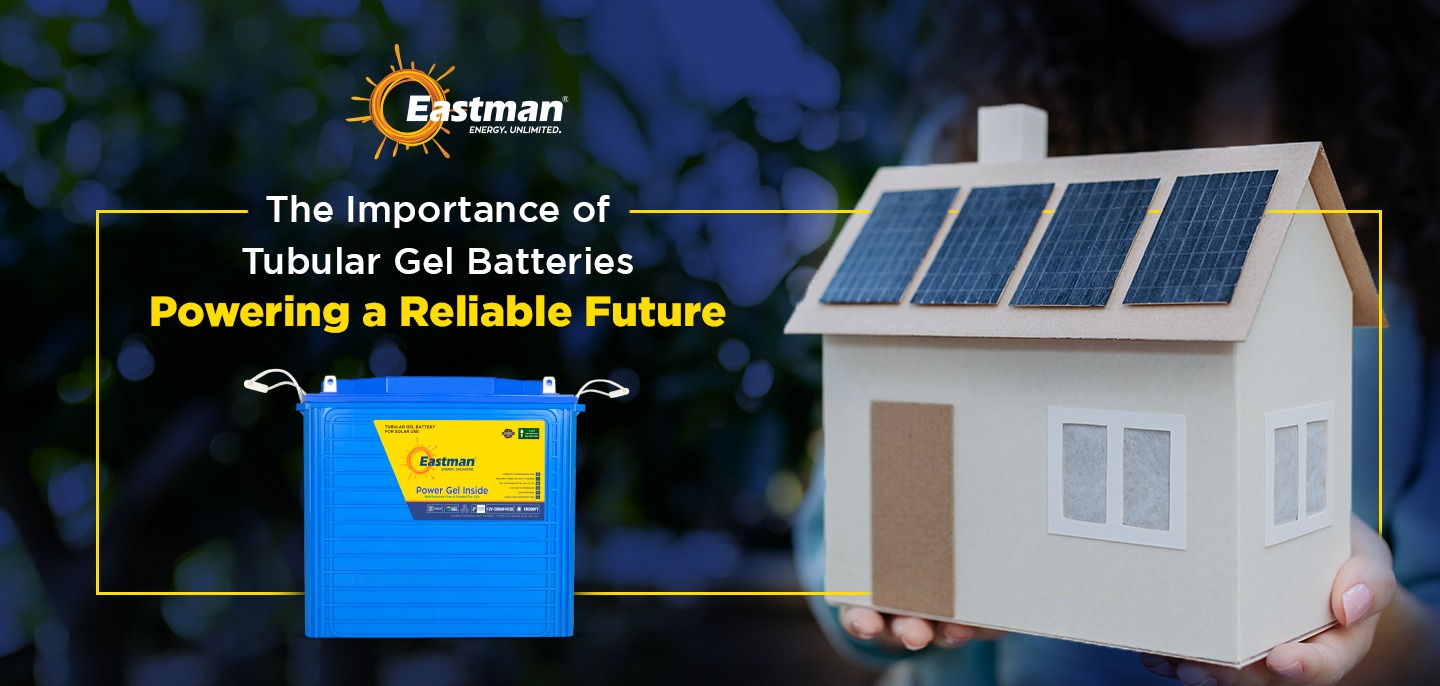
The Importance of Tubular Gel Batteries: Powering a Reliable Future
In today's energy-dependent world, reliable and efficient power storage solutions are indispensable. Whether for renewable energy systems, industrial applications, or everyday use, the demand for advanced battery technologies is growing. Tubular gel batteries have emerged as a frontrunner, offering unmatched durability, efficiency, and versatility.
What Are Tubular Gel Batteries?
Tubular gel batteries combine the tubular plate design with gel-based electrolytes to deliver exceptional performance. Unlike traditional lead-acid batteries, the electrolyte in these batteries is suspended in a silica-based gel, preventing spillage and enhancing safety.
Key Advantages of Tubular Gel Batteries
Enhanced Durability
Tubular gel batteries are built to last, offering a longer lifespan compared to conventional batteries. Their tubular plate design minimizes corrosion, making them a perfect fit for deep cycle applications.
High Efficiency
These batteries are highly efficient, ensuring better charge retention and minimal energy loss. They can deliver consistent performance, even under high-demand conditions.
Low Maintenance
Thanks to the sealed design, tubular gel batteries are virtually maintenance-free. There's no need for regular electrolyte top-ups, reducing upkeep efforts
Eco-Friendly
With minimal emissions and spill-proof construction, tubular gel batteries are an environmentally friendly power solution, aligning well with global sustainability goals.
Wide Temperature Tolerance
Tubular gel batteries perform reliably across a broad range of temperatures, making them ideal for diverse climatic conditions.
Applications in Diverse Sectors
- Renewable Energy Systems: Essential for solar and wind energy storage.
- Telecommunications: Ensuring uninterrupted power supply.
- Industrial Use: Powering critical operations and machinery.
- Backup Power: Supporting homes and offices during outages.
Why Choose Eastman Tubular Gel Batteries?
Eastman stands at the forefront of innovation in battery technology, delivering world-class tubular gel batteries designed to outperform. With a commitment to quality and sustainability, Eastman batteries are engineered for superior efficiency, durability, and reliability.
Eastman Tubular Gel Batteries offer:
- Advanced gel technology for spill-proof and maintenance-free operation.
- Extended cycle life, ensuring long-term performance.
- Robust design for high energy demands and diverse applications.
- Optimal performance in extreme weather conditions.
Power your future with Eastman Tubular Gel Batteries—trusted globally for excellence in energy storage solutions.
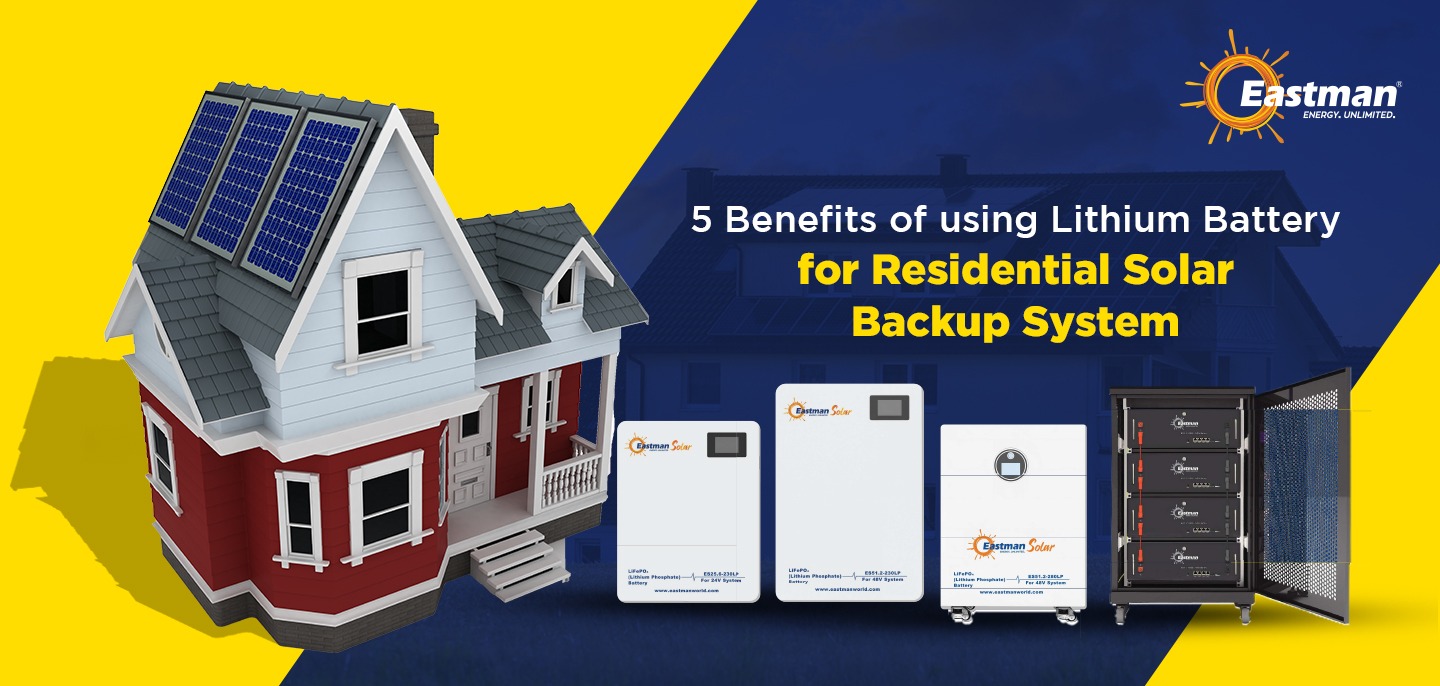
5 Benefits of using Lithium Battery for Residential Solar Backup System
Solar energy is a popular choice for homeowners looking to reduce energy costs and their environmental footprint. However, harnessing solar power effectively requires a reliable storage solution to ensure energy availability when the sun isn’t shining. Lithium batteries are becoming the preferred choice for residential solar backup systems, thanks to their unique benefits. Here’s a look at why lithium batteries are an ideal partner for solar energy storage:
1. Extended Battery Life
Lithium batteries offer an impressive lifespan compared to traditional lead-acid batteries, typically lasting 10-15 years with thousands of charge and discharge cycles. This durability ensures that homeowners get the most out of their investment, as they won’t need to frequently replace their batteries. Longer battery life not only reduces long-term costs but also minimizes maintenance needs, making it a low-hassle solution for solar backup.
2. High Energy Density for Space Efficiency
Lithium batteries are known for their high energy density, allowing them to store substantial energy in a compact form. This makes them especially advantageous for homes with limited space. For example, a lithium battery system can store the same amount of energy as a lead-acid system in a much smaller physical footprint. This compact design enables easy integration into residential spaces and maximizes energy storage without taking up significant room.
3. Efficient Energy Use
Efficiency is crucial in a solar backup system, where stored energy needs to be preserved as much as possible. Lithium batteries typically offer round-trip efficiencies of 90-95%, meaning that most of the stored solar energy is available for use when needed. In contrast, lead-acid batteries often have lower efficiency rates, resulting in more energy loss. Lithium’s high efficiency optimizes solar energy storage, allowing homeowners to make the most of their solar power, even during low sunlight periods.
4. Fast Charging Capabilities
Lithium batteries charge faster than many other types of batteries, which is especially beneficial in solar applications. During limited sunlight hours, quick charging ensures the battery can store as much energy as possible. Lithium’s rapid charging capability also means it can be recharged multiple times throughout the day if needed, which can be useful in areas with variable sunlight. This adaptability helps maximize the power available for nighttime or cloudy days, boosting overall energy security.
5. Eco-Friendly and Sustainable
Lithium batteries are not only efficient but also more environmentally friendly compared to traditional options. They don’t require frequent replacement, which helps reduce battery waste over time. Additionally, many lithium batteries are designed with recyclability in mind, allowing for sustainable end-of-life disposal. By choosing lithium batteries, homeowners can support their commitment to sustainable living and minimize their environmental impact, aligning well with the broader benefits of using solar energy.
Conclusion
As solar adoption grows, choosing the right battery technology is crucial for homeowners who want reliable, efficient, and eco-friendly energy storage. Lithium batteries provide multiple benefits, from long lifespan and high energy density to fast charging and sustainability. With these advantages, lithium batteries stand out as a smart, future-ready investment in solar backup systems that empower homeowners to be energy-independent and sustainable.